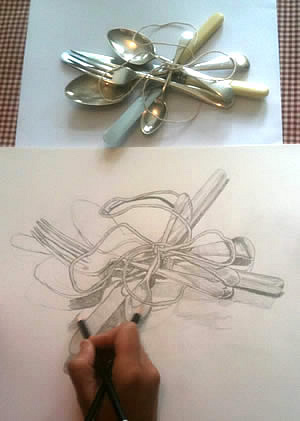The phrase ‘observational drawing’ typically implies drawing from life (see the superb observational drawing exercise set by artist and teacher [Julie Douglas](http://juliedouglasdrawingpaintinglearning.blogspot.com/2012/05/forked-up-drawings-in-pencil.html)). Ask any art teacher and they will list the benefits of drawing from objects that are sitting directly in front of you. You are provided with a wealth of visual information…changing light conditions; rich textures; views of the subject from alternate angles; as well as information from other sense…smells and noise from the surroundings etc. Transcribing from three-dimensions to two is ultimately much harder than drawing from a photograph, but it often results in drawings that are ‘richer’ and more authentic.
*(This doesn’t mean, however, that you should never draw from photographs. Students frequently traipse from home to school and back again: it can be impractical to carry and set up complex still life arrangements over and over again. Some subjects – such as landscapes and nude models – are also unavailable in most classroom settings. It can therefore be good practice to set up a still life arrangement in the flesh (or visit a location) and begin drawing directly from the subject, using photographs to complete the work at home)*